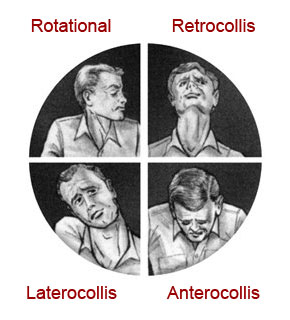Spasmodic Torticollis (ST) can occur any time in life, although the symptoms most frequently occur between 25 and 55 years of age. ST is more common in women than men. The exact cause is unknown.
Onset sometimes comes after an injury to the head or neck, following an infection, or after taking certain medications. There also seems to be a genetic link, with 5 percent of patients reporting at least one relative with ST and 50 percent demonstrating a family history of tremors in the head or hands.
First symptoms generally occur slowly or intermittently and are usually noticed when a person tried to keep his or her head straight, for example, while driving. Family or friends are often the first to see the sign, asking questions like, “Why does your head look like it’s on crooked?” Within two to five years, progression of the disease reaches a plateau without further worsening. The pain associated with ST is almost always focused in one place, frequently the side of the neck or the back of the shoulders.
 There are three distinct varieties of Spasmodic Torticollis: Tonic, in which the head turns to one side, Clonic, which involves the shaking of the head, and Mixed which involves both turning and shaking.
There are three distinct varieties of Spasmodic Torticollis: Tonic, in which the head turns to one side, Clonic, which involves the shaking of the head, and Mixed which involves both turning and shaking.
The turning of the head is generally considered to fall into one of four categories:
- Rotational, in which the head turns to one side or the other
- Laterocollis in which the head is pulled toward the shoulder
- Retrocollis in which the head is pulled to the back, or
- Anterocollis in which the head is pulled forward.
In fact, most people’s ST is more complex, having a combination of “pulling” from among these four categories.

